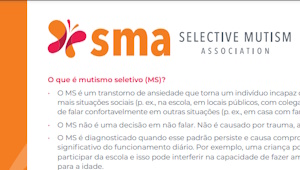Online Library
What is the Difference Between Selective Mutism and Autism?
Selective mutism and autism share several key features and can be challenging at times to differentiate. It is important that children receive a timely, accurate diagnosis to ensure they receive appropriate treatment as soon as possible. This article is intended to provide a general overview of characteristics commonly found in children with selective mutism and autism and help guide you down the right path to getting help for your child.
Let’s Take a Look at Selective Mutism
We know that selective mutism is an anxiety disorder, usually diagnosed in childhood, in which an individual is nonverbal in certain settings and situations, despite being able to communicate when comfortable.
Often, children may:
- Speak freely at home but be nonverbal or minimally verbal at school or public
- Show anxiety in other areas, particularly social anxiety and separation anxiety
- Rely on nonverbal communication such as pointing, nodding, or writing
- Be highly sensitive to how others are feeling
- Struggle to make eye contact or engage with others when uncomfortable
- Have speech or language delays
- Present as behaviorally inhibited in some settings
- Have difficulty engaging with peers in certain settings
- Have difficulty using the bathroom or eating at school
- Show heightened sensory sensitivities
Let’s Explore Autism
Autism, or autism spectrum disorder (ASD), is also generally diagnosed in early childhood. It is described as a spectrum disorder because each person with
autism has varying strengths and challenges and the degree of impairment can vary greatly between individuals. Children with autism all demonstrate some degree of difficulty in social interactions, repetitive behaviors, and communication deficits.
Often, children may:
- Become overly fixated on certain topics or routines (restricted interests)
- Engage in repetitive behaviors such as rocking, spinning, flapping, etc.
- Show anxiety in other areas, particularly specific phobias, social anxiety, and obsessive-compulsive tendencies
- Have difficulty using or understanding nonverbal communication
- Have difficulty understanding other people’s feelings
- Struggle to make or maintain eye contact with others
- Have speech or language delays
- Show periods of regression in speech or social skills
- Repeat words or phrases, called echolalia
- Have difficulty with peer interactions
- Show heightened sensory sensitivities
Let’s Compare!
As you can see from the lists above, many areas of difficulty are common in both autism and selective mutism. The main difference is that children with selective mutism tend to show these challenges mainly when they’re uncomfortable and tend to have fairly typical social interactions and communication skills when they are comfortable. Children with autism tend to have difficulty in all settings, regardless of communication partner or location. The presence of restricted interests or repetitive behaviors is not commonly seen in children with selective mutism.
In some instances, children may have both autism and selective mutism. These children demonstrate the fundamental challenges found in autism along with a discrepancy in communication across settings and individuals. It is important to make sure that difficulties in one area (e.g., language delays due to autism) aren’t the reason a child is having difficulty in another realm (e.g., speaking at school). For example, if a child demonstrates restricted interests, social language impairments, and is nonverbal at home and school, autism may be the appropriate diagnosis. If that same child is verbal at home but does not speak at school, it is possible that the child has both autism and selective mutism.
If you have concerns that your child may have autism and/or selective mutism, the first step would be to speak with your pediatrician about your concerns. Ideally, you would want to schedule an evaluation with a provider that is knowledgeable about selective mutism and autism, but if one isn’t available in your area you could start with a provider that has experience with selective mutism. A list of providers can be found at https://www.selectivemutism.org/find-
support/.
Author:
Brenda Ray, MS, CCC-SLP
Speech Language Pathologist




